Good Morning Everybody,
Well, the best laid plans went astray for today. I was planning to be on an all day portfolio building photo shoot, but the rain over the last several days has put a damper, (no pun intended) on today's session.
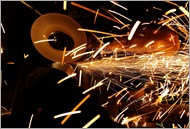 You know, one of the best ways to "sharpen the saw" as they say, is to practice. How many of us take the time to do just that? Unfortunately, not many - heck, me included lots of times. That's why I was looking forward to today's shoot.
You know, one of the best ways to "sharpen the saw" as they say, is to practice. How many of us take the time to do just that? Unfortunately, not many - heck, me included lots of times. That's why I was looking forward to today's shoot.
The good news is that I'm doing a shoot for are state KPPA Summer School on Monday - it's only for a few hours but it will still be fun because it's in a location I've never photographed in before. I'll share a few images with you next week after we return.
As usual I’ve gotten a little off tract, but why don't you think about it. Why not get a few like minded photos together, hire a few models from Model Mayhem or Craig's List and just go out and PRACTICE. I promise you, you'll enjoy it ;~)
I've Got To Focus, Really Focus Today
Have you ever really practiced how to focus? I know, right off the bat, you're thinking I'm crazy for even bringing it up. You're thinking, "David, the cameras all have built in focusing systems. Why do I need to KNOW how to focus? The camera does it for me."
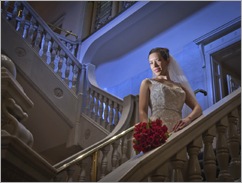 Well, you are absolutely right to say the cameras have built in focus, but I can tell you from experience that lots of folks don't know how to use the camera's built in focus functions. I was teaching one of my Master Classes a few years ago. By the way, our next Master Class Workshop [link] is scheduled for October 18-22, 2010. Anyway, we were photographing a bride on the stairs at one of my favorite wedding venues, the Phoenix Club, in downtown Cincinnati.
Well, you are absolutely right to say the cameras have built in focus, but I can tell you from experience that lots of folks don't know how to use the camera's built in focus functions. I was teaching one of my Master Classes a few years ago. By the way, our next Master Class Workshop [link] is scheduled for October 18-22, 2010. Anyway, we were photographing a bride on the stairs at one of my favorite wedding venues, the Phoenix Club, in downtown Cincinnati.
I was showing the class how I was framing up the bride in the composition and thought I was getting some exciting images. One of the class members stepped in to try to duplicate the shot and was surprised by her really blurry result. She showed me the image on her LCD screen and it was definitely blurry.
Hit the “Read More…” link below for the rest of the story.
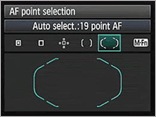 I did some further checking of her camera settings and discovered that she really didn't understand how the focusing features worked on her camera.
I did some further checking of her camera settings and discovered that she really didn't understand how the focusing features worked on her camera.
She had ALL the focus spots activated so when she set up my shot in her viewfinder with the bride in Quadrant #3, guess what? The camera didn't know it was supposed to focus on the bride. With ALL the focus spots activated, it simply focused on the object closest to the camera, which, as you can see in the photograph, was the marble staircase railing.
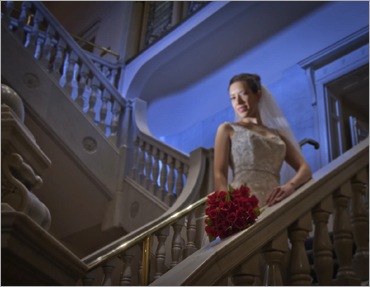 In her shot, the railing in the viewfinder was in sharp focus, but because on the large aperture we were shooting with, the bride went quickly out of focus because of her greater distance from the focus plane.
In her shot, the railing in the viewfinder was in sharp focus, but because on the large aperture we were shooting with, the bride went quickly out of focus because of her greater distance from the focus plane.
Why do some folks have this problem? You know, back in the days of film and manually focused cameras, photographers all did the same thing - focus on the subject and then reframe the image for the best composition. It was just the natural thing to do.
 With the advent of auto focus cameras….. Who can remember brand and model? It was the Minolta Maxim 7000 introduced in January 1985! I had one of the first cameras available. It was way cool how it worked - no more manual focusing I thought till I discovered I was having focusing problems with an AUTOFOCUS camera!
With the advent of auto focus cameras….. Who can remember brand and model? It was the Minolta Maxim 7000 introduced in January 1985! I had one of the first cameras available. It was way cool how it worked - no more manual focusing I thought till I discovered I was having focusing problems with an AUTOFOCUS camera!
I quickly learned that if I focused on the subject, then held the shutter button down half way to hold the focus and then reframed the shot, my problems went away.
Today we have cameras with a gazillion focusing points, we can even dial in whichever one we want and just shoot away. But what is the best and quickest way to shoot? Turns out that the technique I used in the old film manual focus days works just fine in this brand new digital millennium of ours.
So this is a long story with a short conclusion. How do I focus when I’m shooting?
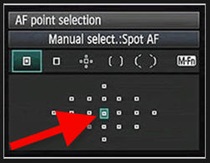 Simple. I first set my camera to ONLY use the center focusing spot on the focus grid. Now I can quickly grab focus on the subject, and with the shutter button held halfway down, I can quickly reframe the composition and get my best shot without losing focus on the subject. That, by the way, is how I have all my cameras set up - center spot focus only.
Simple. I first set my camera to ONLY use the center focusing spot on the focus grid. Now I can quickly grab focus on the subject, and with the shutter button held halfway down, I can quickly reframe the composition and get my best shot without losing focus on the subject. That, by the way, is how I have all my cameras set up - center spot focus only.
I need to point out that this is NOT how I would set up my camera when, say shooting fast moving sports where the center of interest is quickly changing. But for me, as a "people photographer", this is the only way to shoot if you want to be assured of rock solid focused images.
DAZNOTE: You can find a additional information on the Canon 7D at Imaging-Resource.com right here. They have a nice write up on focusing as part of their hands on user report.
If you've been having focusing issues, you just may want to give my technique a try. May all your pixels be sharp from this point forward ;~)
__________________________________________________
Hey gang, that's it for me today. We've a BIG project we're working on this week and I need to get back to work if we are going to pull it off. More later.....
Everybody have a great day and I'll see you bright and early tomorrow for another very profitable Business Day Thursday.
See ya' then, -David

Hi David,
ReplyDeleteyou wrote "and with the shutter button held halfway down, I can quickly reframe the composition"
I'm a bit confused as I was told that you should actually not do it in this way. Rather recomposing you should compose the picture and then use the focus points (9 or 16) to set the focus on your subject. Reason for this is that you might change distance by moving the camera when you re-compose the shot. Is that correct ?
I am a bit confused now David, when watching D-Town TV the other week they said that if you focus and then re-compose it alters the focal length, they said to choose a focal point closest to where the subject is.
ReplyDeleteThanks for the info! I was curious if you could talk about whether this is still (or would be) your "go to" way of achieving the best focus if you're shooting "wide open"? I've heard quite a few people saw that if you're shooting at 1.4 or something similar that you can throw your focus off by using the "focus and recompose" method. What are your thoughts?
ReplyDeleteI actually like having multiple focus points to use. A dozen or so seems to be the ideal for me. The new cameras with 51 AF points is a bit much in my opinion, at least for photographing people. I tend to use the 6 or so points around the "rule of thirds" lines the most. With my Nikon's "crosspad" it's easy to switch them very quickly. I occasionally use the center point and recompose technique, but usually use those 6 or so AF points. Sometimes I use the outer focus points if there is the opportunity, so I like having them there, too. 51 is just too much to be of any use to me, although I could see using them as a wildlife photographer trying to shoot birds in the "bush."
ReplyDeleteI had never before heard the objection to focusing and recomposing based on the notion that it would change the focal distance (if it changes the focal length, there's something really seriously wrong :) )
ReplyDeleteI can see there's some truth to the idea - simple geometry would suggest this is true unless the camera is rotated in space about the optical center of the lens - but I have taken literally tens of thousands of frames this way and have never encountered this effect as a practical limitation - even at very wide apertures, I guess there is still enough DOF to accommodate any putative change in focal distance.
Interestingly, in the one case where it might make enough of a difference to matter - macro - I have the camera locked down and use manual focus with magnified live view anyway.
Final thought in favor of the focus-and-recompose school of thought - on many cameras, the center auto-focus point is more sensitive than the others, which is another reason to use it over any of the others.
Hi David,
ReplyDeleteI'm an old-time film shooter too and still use the centre point & recompose method of focus. Works nearly all the time.
Why nearly ? at f/1.2 the slight change in tilt of the focal plane when recomposing causes my subject to go out of focus.
The other big tip I have to offer is a change in the custom preferences (on a Canon body at least), to remove AF from the shutter release. That way I can focus with the AF-On button on the rear of the camera, and then when ready to shoot (or if in AI-Focus mode), I can press the shutter and not worry that the camera is going to refocus on me.
David,
ReplyDeleteI have been using this technique since I started using DSLR's. Some because I am lazy err... Efficient and it follows the KISS methodology.
The only problem when shooting other than Manual, the exposure will pick up the different lighting and throw it off. That's why Canon put that little star button on the back of the camera for AE Lock.
As you know this locks the exposure at the center focus point (or other if selected) until the shutter is pressed allowing you to recompose and take the shot.
I am not sure about the 7D but the 5D Mk II will always expose to the AF point when in Evaluate metering. Personally I never go there.
Ken's comment about Macro is a good one as you should probably be on a tripod anyhow.
Take care.
You should have come out with me! I did a beautiful waterfall shoot!
ReplyDeleteI have two images up on facebook and the rest will be up on the blog monday.
It was wet and muddy, but worth it.
http://www.facebook.com/profile.php?id=1297399483&v=wall&story_fbid=135115259838813#!/photo.php?pid=31394709&id=1297399483
Hi David,
ReplyDeleteI’ve been practicing a tip I learned on using the Multi-controller button on the back of Canon cameras. On my 5D it’s custom function 13, (AF point selection method). The neat thing is you can use any of the focus selection points by merely touching the button. Of course you must pay attention to which focus point you are really using when things get a little crazy during a wedding shoot. What I’ve learned is to return to the center position (my default) after choosing any of the other focus points.
Mark
It looks like your RSS feed settings have been modified, which is very unfortunate. Previously I was able to your view full posts along with pictures in Google Reader, but now it displays only a few lines of text.
ReplyDeleteAndris...I'm with you. I don't particularly care for new way the posts show up in Google Reader...
ReplyDeleteOn the note of recomposing with the shutter have way depressed I find this too cumbersome and prefer to reassign the focus to another button on my camera...
Dave,
ReplyDeleteI have always used center point with "focus-recompose" to simplify things. But, when I got my 5D II, I went through my own focusing tests in low light to validate how well it performed against my 40D. I found that the center spot was more accurate. So, being a gearhead by background, I felt the need to know why and called Canon. The tech guy said the center point reads contrast on a vertical and horizontal axis, while the other points generally read contrast in one axis only. Also, I found that with my 85/1.2 lens at say, f/1.6, and very close to the subject, focus-recompose didn't work very well (due to out-of-plane motion when swinging the camera through a small arc). So, it does have its limits. -Stuart
under f/4, be very careful with recompose....
ReplyDeletejust my two cents
Gokhan